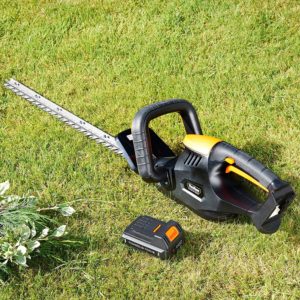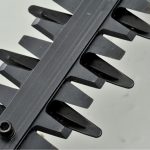Your hedge trimmer is a fantastic tool which you are likely to use a great deal in the spring, summer, and perhaps early autumn. It is very unlikely to get out and power up during the winter. This is for the simple reason that the plants are growing minimal amounts at this time. So you don’t need to cut them back. That’s why you will probably put your best hedge trimmer into storage.

It’s very important to take a bit of time to make sure your tool is prepared properly before storing it. Giving it due care and attention will reduce the chance of the blades suffering over the winter. As a result it will be ready to use straight away when you get it out in the spring.
The chances are that once the hedges are in need of attention, you will not want to take the time to start cleaning and sharpening and lubricating the blades. So it’s a very good idea to do all of this in advance.
Where To Store Your Hedge Trimmer?
You should think carefully about the space in which you are going to store your hedge trimmer. It ought to be dry, e.g. a leak-proof shed, and will preferably have minimal dust. This may mean cleaning out the space beforehand to ensure your tools stay dust-free. In addition you could consider covering them with a cloth if this is not practical.
It is best to store hedge trimmers or hedge cutters off the floor if possible, allowing you to coil the cable (if applicable) out of harm’s way. Another vital point is to keep the blades out of reach of children. If your hedge trimmer came with a cover, you should store it inside.
Never store hedge cutters outdoors, in either the winter or the summer, even if they are under shelter. The moisture in the air will still contact the blades and mechanism and will destroy them.
This is also valid for storing your best hedge shears.
Take Care For The Batteries of Cordless Hedge Cutters
If storing your best cordless hedge trimmer, it’s important to remember to remove the battery pack first. Batteries ought to be stored inside your house rather than a shed in a cool, dry place. Some battery packs are sensitive to the cold, and freezing could damage them.  Depending on the model, some of them need to be stored fully charged. So please check your manufacturer’s guide before putting them away.
Depending on the model, some of them need to be stored fully charged. So please check your manufacturer’s guide before putting them away.
Storing your batteries indoors reduces the chances of them suffering from extreme temperatures or getting damp. Even if you choose to store the battery in your shed, you should remove it from the trimmer, as this will ensure it does not ruin the trimmer if it leaks for some reason.
How To Store Petrol Hedge Cutters
Petrol powered hedge trimmers ought to have all the fuel drained out of them before you store them. If you leave it, the fuel will probably go stale. This may prevent your tool from starting up properly next time you use it. As a result it can cause damage to the engine, which may be expensive to repair. So draining the fuel tank is an important step which you shouldn’t neglect when prepare for the winter.
Conversely, you should make sure that the oil tank is not empty, but instead is topped up with a quality oil. Once again checking the manual for any recommendations is a good idea.
Clean The Trimmer Before Winter Storage
Another important thing to do before storing your hedge trimmer is to thorough clean it. This will prevent the chances of clogged debris damaging the blades as it breaks down over the winter months, and also means you’ll be ready to go as soon as you need to use the trimmer in the spring. Removing the debris while it’s still fresh should be a lot easier than trying to scrape off long-dried grass and sap which has welded itself to the blade.

Make sure that you protect your hands and unplug the trimmer, then thoroughly clean it, disassembling any parts which you need to clean the inside of. It’s always a good idea to take the opportunity to do a thorough deep-clean at this time of year, rather than in the season when you’re using the trimmer regularly, so take a bit of time over it and do a thorough job. There are plenty of model-specific how-tos available online, both in video and written format, so if you need any guidance, you should be able to find it. Once you’ve finished, reassemble the hedge trimmer carefully.
Remove The Rust
As part of the cleaning process, you should also check your hedge trimmer thoroughly for signs of rust or corrosion. Remember to check the underside of the trimmer’s teeth, where rust may be harder to spot. If you find any, address the problem immediately to prevent it from spreading.
You can lightly rub rust away using sandpaper, and then spray or rub down all the metal surfaces with a suitable lubricant to protect them from moisture. After lubricating the blades, allow the trimmer to run for a few minutes to make sure the oil is evenly distributed across all the blades. Thoroughly lubricating them will protect them throughout the winter storage.
Sharpen Hedge Trimmer Blades
It’s also advisable to sharpen your hedge trimmer blades before you put it away. This should be done prior to cleaning to ensure that any leftover debris/metal fibres are removed. Again, ensure that the hedge trimmer is unplugged and that you are wearing adequate protection before you begin working on the blades. You can sharpen the blades using a file and a sharpening stone.

Working methodically from tooth to tooth, sharpen each blade to an apex point and use the sharpening stone to remove any snags on the teeth. Once finished, thoroughly clean the trimmer, wipe down the blades, and apply your chosen lubricant in a generous coat.
Conclusion
Taking the time to properly service and clean your hedge trimmer before storing it does not only save you time when you take the trimmer out again in the spring. It will improve the life of your trimmer blades and reduce the chance of the machine rusting during the damp winter months, particularly if you thoroughly lubricate all the metal surfaces before putting it away. Taking out leftover fuel and removing battery packs protects your trimmer from potential damage and costly repairs.










